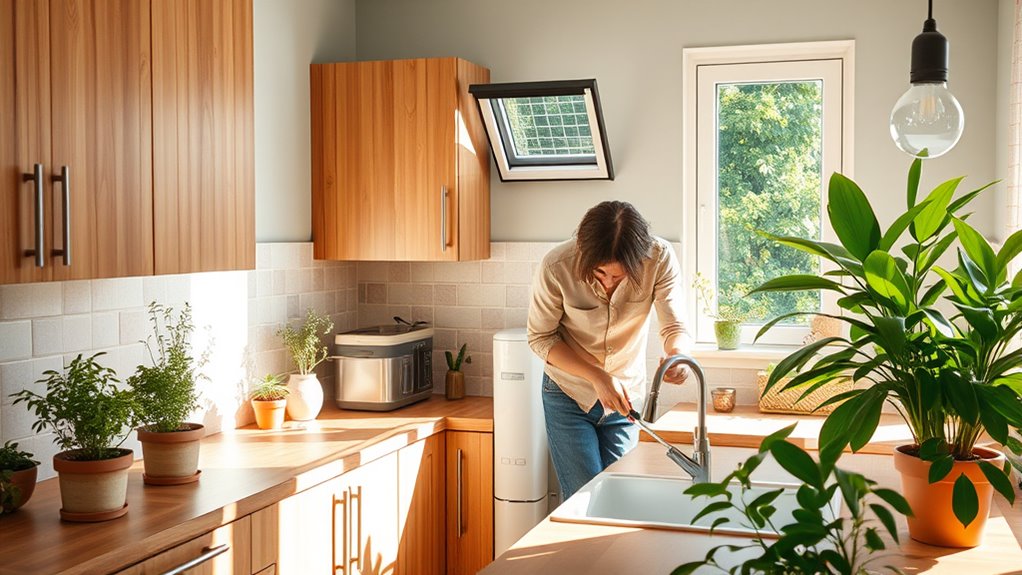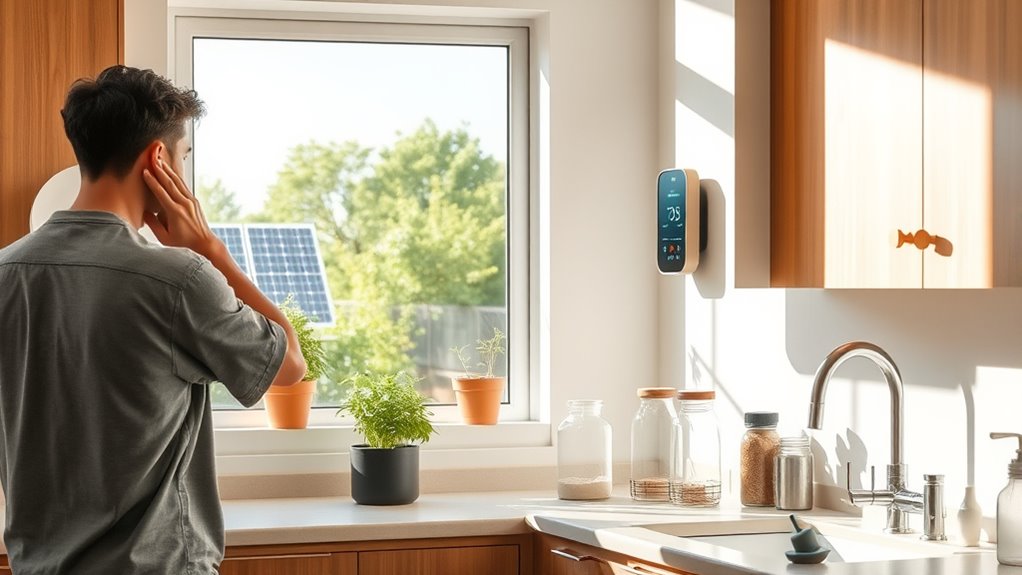To reduce your carbon footprint at home, switch to renewable energy sources like solar or wind, and consider installing solar panels. Use eco-friendly products with biodegradable ingredients, and replace your bulbs with energy-efficient LEDs. Fix leaks, install low-flow appliances, and drought-resistant plants to conserve water. Unplug devices and upgrade to Energy Star-rated appliances to save energy. Embracing these sustainable habits can make a big difference; explore further to discover more ways to live greener.
Key Takeaways
- Switch to renewable energy sources like solar, wind, or hydroelectric power to cut household carbon emissions.
- Use energy-efficient appliances and LED lighting to reduce electricity consumption.
- Install water-saving fixtures such as low-flow showerheads and fix leaks promptly.
- Choose eco-friendly, biodegradable products and reusable items to minimize waste and pollution.
- Incorporate sustainable practices like planting drought-resistant plants and unplugging devices when not in use.

Have you ever wondered how small changes in your daily routine can make a big difference for the environment? One of the simplest ways to start is by rethinking your energy sources. Switching to renewable energy is a powerful step toward reducing your carbon footprint. Many utility providers now offer options for wind, solar, or hydroelectric power, so you can choose to support cleaner energy production. If that’s not available in your area, consider installing solar panels on your roof. While the upfront cost may seem steep, the long-term savings and environmental benefits outweigh the initial investment. Using renewable energy means you’re relying less on fossil fuels, which are major contributors to greenhouse gases. This change alone can considerably lower your household’s carbon emissions and set a positive example for others. renewable energy resources are becoming increasingly accessible and affordable, making this an even more practical choice for homeowners.
Switching to renewable energy reduces your carbon footprint and supports a cleaner, greener future.
Next, pay attention to the products you bring into your home. Opt for eco friendly products whenever possible. From cleaning supplies to personal care items, choosing products made from natural, biodegradable ingredients reduces pollution and minimizes harmful chemical runoff. Look for certifications that indicate eco-friendliness, and buy in bulk to cut down on packaging waste. Additionally, choosing reusable items like cloth bags, stainless steel water bottles, and beeswax wraps instead of single-use plastics further diminishes your environmental impact. Each small switch adds up over time, helping to conserve resources and reduce the amount of waste sent to landfills.
Incorporating energy-efficient appliances and lighting is another crucial step. Replace incandescent bulbs with LED bulbs—they use a fraction of the energy and last much longer. When shopping for appliances, check for energy star ratings, which indicate higher efficiency. These upgrades not only cut your electricity bill but also lessen the demand on power plants, many of which burn fossil fuels. Also, make a habit of unplugging devices when they’re not in use; many electronics draw power even when turned off, a phenomenon called phantom load. These unconscious energy drains can be easily eliminated with power strips.
Finally, be mindful of your water use. Fix leaks promptly, install low-flow showerheads, and use drought-resistant plants in your garden. Water conservation isn’t just about saving a resource; it also reduces the energy required to pump, heat, and treat water. When you combine these efforts—embracing renewable energy, choosing eco friendly products, improving energy efficiency, and conserving water—you create a broad approach to sustainable living. Small, consistent actions in your home can lead to meaningful change for the environment, making your lifestyle more eco-conscious and resilient for the future.
Frequently Asked Questions
How Can I Measure My Current Carbon Footprint Accurately?
You can measure your current carbon footprint accurately by using carbon footprint calculation tools available online. These tools prompt you to input data about your energy use, transportation, and waste. To improve accuracy, consider using emission measurement tools like smart meters or energy monitors that track real-time consumption. Regularly updating your data helps you understand your impact better and identify areas where you can reduce emissions effectively.
What Are the Best Low-Cost Sustainable Home Upgrades?
You can start with affordable upgrades like installing solar panels to harness clean energy and reduce reliance on fossil fuels. Adding compost bins helps cut waste and creates nutrient-rich soil for your garden. Both options are cost-effective, environmentally friendly, and easy to implement. These simple improvements make a big difference in lowering your carbon footprint while saving you money over time. Plus, they promote a more sustainable lifestyle at home.
How Do I Encourage Family Members to Adopt Eco-Friendly Habits?
You might think getting family involved is tough, but start small to encourage eco-friendly habits. Share the benefits of sustainable living and involve everyone in decision-making, making it a team effort. Use family involvement to build habit formation, making eco-friendly actions part of your daily routine. Celebrate small successes together to motivate continued effort. Over time, these habits become second nature, helping everyone contribute to a greener home.
Are There Government Incentives for Sustainable Home Improvements?
Yes, there are government incentives like grants and tax credits available for sustainable home improvements. You can apply for government grants that help cover the costs of installing solar panels, energy-efficient windows, or insulation. Additionally, tax credits often reduce your tax bill when you make eco-friendly upgrades. Check your local and federal programs regularly, as these incentives can change, making it easier and more affordable to adopt sustainable practices at home.
How Can I Reduce Water Usage Alongside Energy Conservation?
You can slash your water usage by adopting water efficiency and conservation techniques that are as powerful as a tidal wave! Fix leaks promptly, install low-flow showerheads, and use drought-tolerant plants. Turn off taps while brushing your teeth and use rainwater for outdoor tasks. These simple yet effective actions help conserve water, reduce your utility bills, and support environmental health—making a huge impact with just a few small adjustments.
Conclusion
By making small changes at home, you’re like a gardener tending to a thriving garden—each action helps your environment flourish. Every step you take to reduce your carbon footprint adds up, creating a cleaner, greener world for yourself and future generations. Remember, sustainable living isn’t about perfection but progress. So, keep embracing eco-friendly habits, and watch how your efforts bloom into a healthier planet—one simple step at a time.









